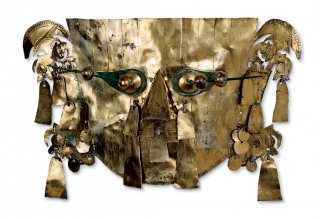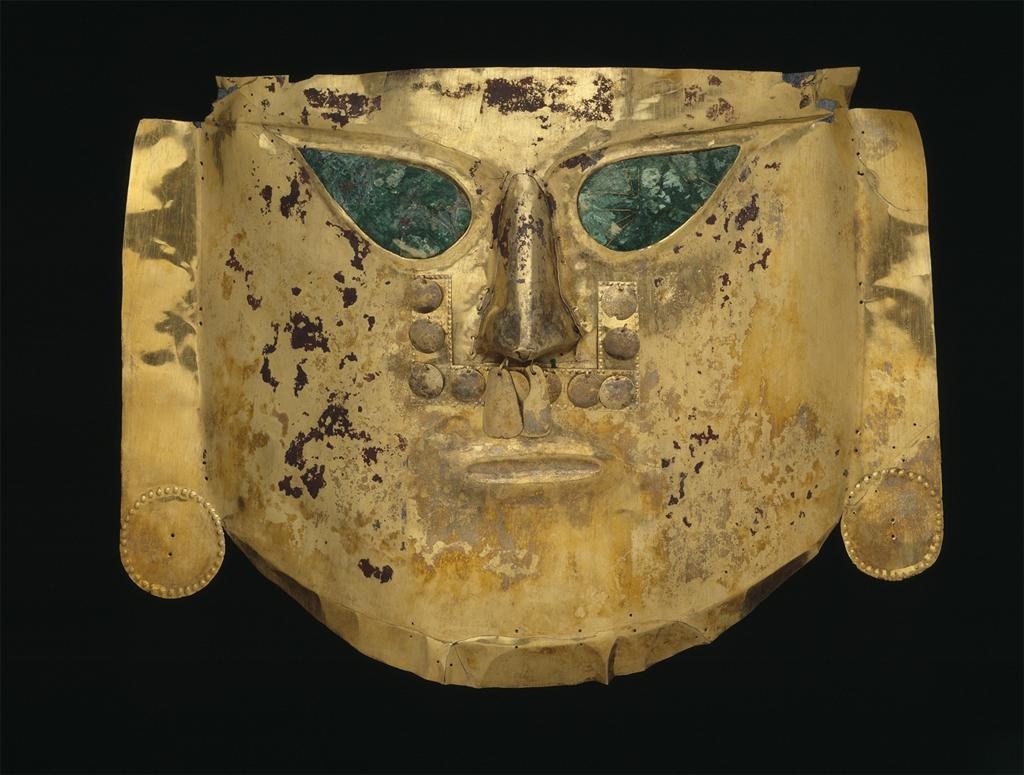
Sicán or Chimú
Mummy Mask
Peru Gold 10 ½ x 16 ½ in Museum purchase with funds provided by Mr. and Mrs. Ralf Kircher and Mr. Louis Jacobs 1967.46
Facing the Next Life
What would you wear into the afterlife? This mask presents a shining example of something the mummy of an elite person from ancient Peru might wear, made with the latest craftsmanship and decoration of the time.
A Day in the Life
Tools and Techniques
Behind the Scenes
Look Closer
Excellence is in the Details
This mask comes from either the Sicán and Chimú cultures, but at this point we cannot be certain which one. Both lived in the north coast of Peru and had strongly hierarchical political structures, with ruling elite who were buried in opulent tombs. The Sicán emerged around 750 CE and developed sophisticated technology working with metals (see “Tools and Techniques”). The Chimú emerged in the 1100s and, around 1375, conquered the Sicán. This led to the increased integration of Sicán technology, artistic styles, and even craftsmen in Chimú culture. This mask was found in an excavation near Chan Chan, the capital of Chimú. Around 1470 the Inca conquered the Chimú.
Burial masks such as this one share similar features—the overall shape, the tear-drop eyes, and the rectangular ears—but they also have unique details that set each one apart. Compare The DAI’s mask with two others in American museums pictured below. The DAI’s is notable for having the cut-out spangles and protruding eyes in tact.

Ceremonial Mask, 900–1100, Peru; Sicán (Lambayeque), Gold, copper and paint. The Dallas Museum of Art.

Funerary Mask, 10th–11th century, Peru; Sicán (Lambayeque), Gold, cinnabar, copper overlays. The Metropolitan Museum of Art.
Further reading: Izumi Shimada, “The Late Prehispanic Coastal States,” in The Inca World: The Development of Pre-Columbian Peru, A.D. 1000–1534, edited by Laura Laurencich Minelli (Norman: University of Oklahoma Press, 2000), 49–110.
Just for Kids
Look!
When you think about a mummy do masks come to mind? You are probably thinking about pyramids or an Egyptian pharaoh. Like in Egypt, leaders in Peru were mummified and buried in large tombs. The tombs were filled with objects that were needed in the afterlife. The mask would be placed on the mummy for protection. This mask originally was decorated with paint, feathers, jewels, and other metals.
When do you wear a mask or costume? Look around for other masks in the museum. How are they alike and different? Why do you think they are worn?
Signs & Symbols
Dig Deeper
Arts Intersected
The Sculpture Speaks
Did You Know?
Hidden Gold
In both the Sicán and Chimú cultures, gold was a material reserved for the ruling elite. They enjoyed the brilliance of gold as much as we do today. However, burial masks like this were often covered with decoration, such as red, green, or white paint, colored feathers, precious stones, or other metals such as silver or copper. Imagine how this mask would change if you could not see the gold and if this would make it more or less striking. You can see an example of a mask with traces of paint and copper in “Look Closer.”
Further reading: Paloma Carcedo Muro and Izumi Shimada, “Behind the Golden Mask: The Sicán Gold Artifacts from Batán Grande, Peru,” in The Art of Precolumbian Gold: The Jan Mitchell Collection, edited by Julie Jones (Boston: Little, Brown and Company, 1985), 60–75.
Expert Opinion
Look Around
Putting on a Show
People from many times and places have used masks, ranging from activities such as burials and rituals to entertainment. Always there is a sense that a mask enables a kind of performance. This gold mask covered the face of a mummy of an important person in the Sicán or Chimú cultures in ancient Peru. The three-dimensional features enhanced moving the mummy to its grave during a burial procession, the many dangling spangles and the protruding eyes creating a sense of life as they reflected light.
Compare this with other masks in The DAI’s collection, such as the Malakulan Double-faced Headdress Mask, or the Bamileke Elephant Mask. These also are made with valuable materials, but they were used in very different activities, as part of special societies. As you look at them, consider where masks appear today and what kinds of performances they facilitate.
Further reading: Joanne Pillsbury, “Funerary Mask,” 2015, http://www.metmuseum.org/art/collection/search/309959.
About the Artist
Talk Back
Taking It to the Grave
This elaborate gold mask indicates the wealth and importance of the person with whom it was buried. In many cultures, such as ancient Egypt or China, objects of great skill and beauty were often made for graves and would never have been seen again. How does art play a role in mortuary practices today? How does this reflect changes in our thoughts about the afterlife?

